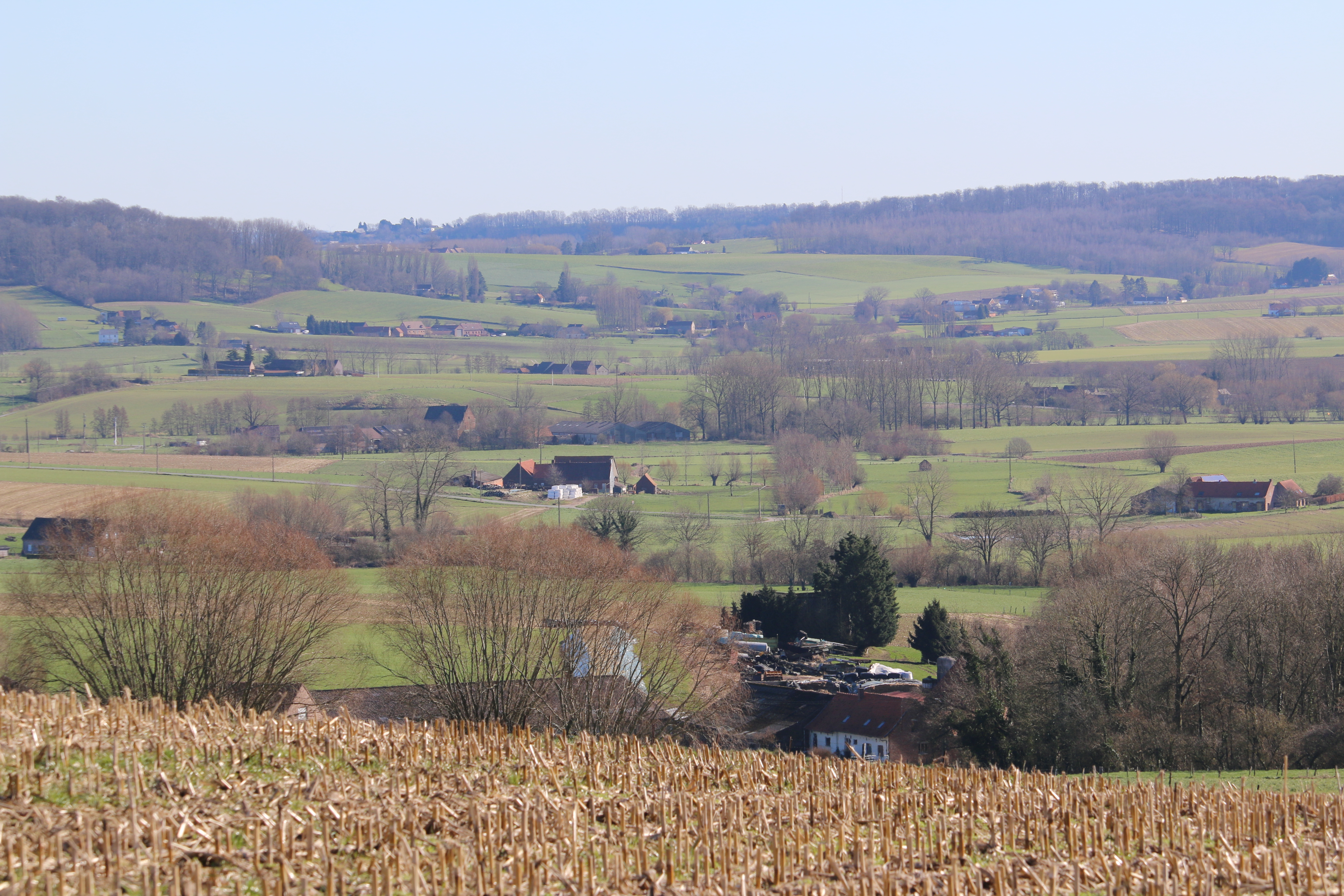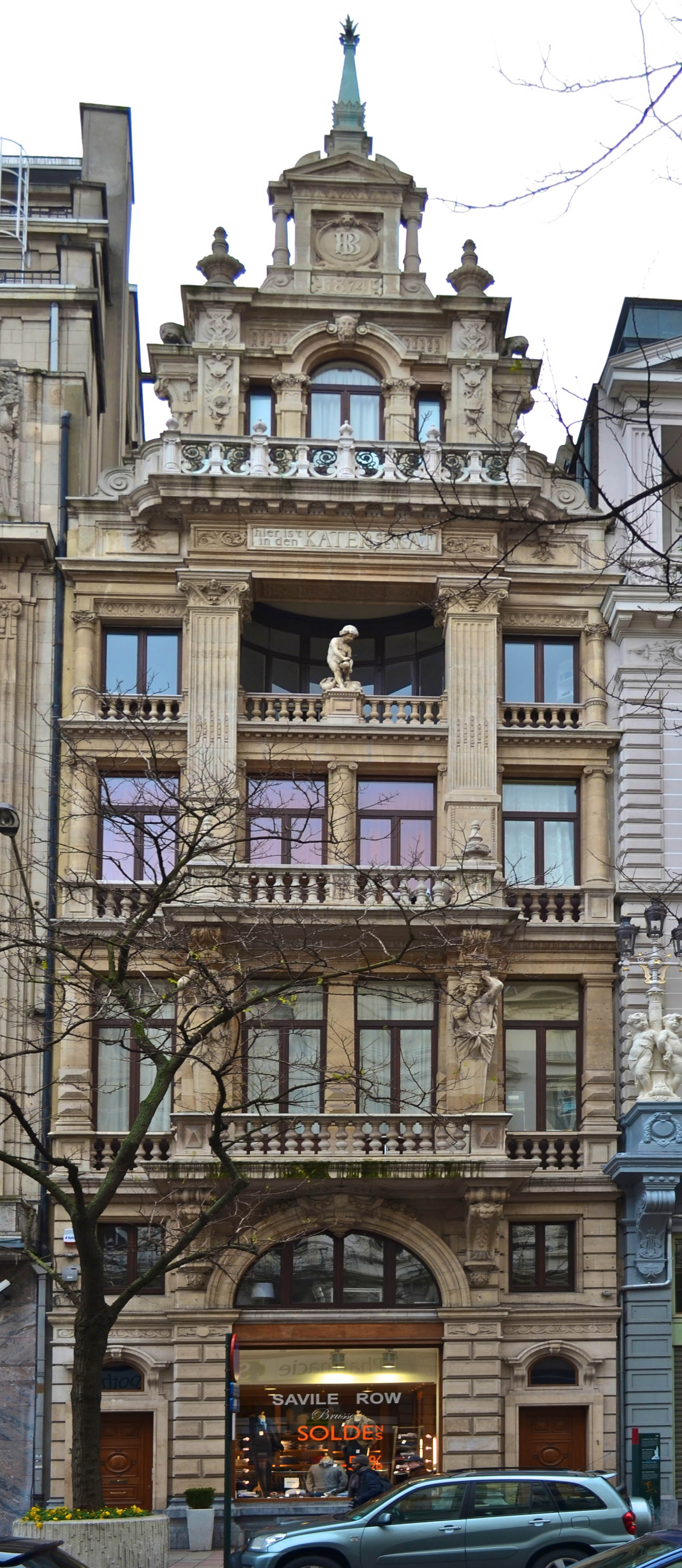|
Tournai Railway Station
Tournai railway station (; ) is a railway station in Tournai, Hainaut, Belgium, situated on railway line 94. It is operated by the National Railway Company of Belgium (SNCB/NMBS). History The first train arrived there on 24 January 1842. A first neoclassical stone building dating from the 1840s was later dismantled and replaced to serve as the railway station of the town of Leuze-en-Hainaut. The current station building was designed by the architect Henri Beyaert and erected between 1874 and 1879. The monumental building originally included a glass and iron construction covering the platforms and rails, and a freight station located in a separate building conceived in the form of a late-medieval Flemish cloth hall. The buildings were severely damaged during World War II. The structure covering the platforms and tracks was demolished and replaced by simple awnings covering the platforms. Train services The station is served by the following services: [...More Info...] [...Related Items...] OR: [Wikipedia] [Google] [Baidu] |
:Category:Railway Stations In Belgium
{{Portal, Belgium Belgium Stations Belgium Belgium, officially the Kingdom of Belgium, is a country in Northwestern Europe. Situated in a coastal lowland region known as the Low Countries, it is bordered by the Netherlands to the north, Germany to the east, Luxembourg to the southeas ... Transport buildings and structures in Belgium Passenger rail transport in Belgium ... [...More Info...] [...Related Items...] OR: [Wikipedia] [Google] [Baidu] |
Neoclassical Architecture
Neoclassical architecture, sometimes referred to as Classical Revival architecture, is an architectural style produced by the Neoclassicism, Neoclassical movement that began in the mid-18th century in Italy, France and Germany. It became one of the most prominent architectural styles in the Western world. The prevailing styles of architecture in most of Europe for the previous two centuries, Renaissance architecture and Baroque architecture, already represented partial revivals of the Classical architecture of Roman architecture, ancient Rome and ancient Greek architecture, but the Neoclassical movement aimed to strip away the excesses of Late Baroque and return to a purer, more complete, and more authentic classical style, adapted to modern purposes. The development of archaeology and published accurate records of surviving classical buildings was crucial in the emergence of Neoclassical architecture. In many countries, there was an initial wave essentially drawing on Roman archi ... [...More Info...] [...Related Items...] OR: [Wikipedia] [Google] [Baidu] |
Rail Transport In Belgium
Rail transport in Belgium benefits from an extensive rail network. The country is a member of the International Union of Railways (UIC). The UIC Country Code for Belgium is 88. History On May 5, 1835, the first railway in continental Europe opened between Brussels-Groendreef/Allée verte and Mechelen. Some sort of railroad or canal had been envisaged as early as 1830. The feasibility of a railroad was investigated by engineers Pierre Simons and Gustave De Ridder. The first trains were Stephenson engines imported from Great Britain. The engines were called ''Pijl'' meaning Arrow, ''Olifant'' meaning Elephant, and 'Stephenson' (named after its designer). They pulled bench-cars and diligences. On the return from Mechelen, the ''Olifant'' pulled all 30 cars. By 1840, Ghent, Bruges, Ostend, Antwerp, Mechelen, Brussels and Leuven were connected. The lines that had to reach Liège, Mons and Kortrijk were partially completed. In 1843, when the major East-West/North-South axes were co ... [...More Info...] [...Related Items...] OR: [Wikipedia] [Google] [Baidu] |
List Of Railway Stations In Belgium
Belgium has an extensive passenger railway network managed by the National Railway Company of Belgium. List of stations A B C D E F G H I J K L M N O P Q R S T U V W Y Z References {{Railway stations in Europe Railway stations in Belgium, Lists of railway stations in Belgium, Belgium transport-related lists, Railway stations ... [...More Info...] [...Related Items...] OR: [Wikipedia] [Google] [Baidu] |
World War II
World War II or the Second World War (1 September 1939 – 2 September 1945) was a World war, global conflict between two coalitions: the Allies of World War II, Allies and the Axis powers. World War II by country, Nearly all of the world's countries participated, with many nations mobilising all resources in pursuit of total war. Tanks in World War II, Tanks and Air warfare of World War II, aircraft played major roles, enabling the strategic bombing of cities and delivery of the Atomic bombings of Hiroshima and Nagasaki, first and only nuclear weapons ever used in war. World War II is the List of wars by death toll, deadliest conflict in history, causing World War II casualties, the death of 70 to 85 million people, more than half of whom were civilians. Millions died in genocides, including the Holocaust, and by massacres, starvation, and disease. After the Allied victory, Allied-occupied Germany, Germany, Allied-occupied Austria, Austria, Occupation of Japan, Japan, a ... [...More Info...] [...Related Items...] OR: [Wikipedia] [Google] [Baidu] |
Cloth Hall
A cloth hall or linen hall (; ; ; ) is a historic building located in the centre of the main marketplace of a European town. Cloth halls were built from Medieval architecture, medieval times into the 18th century. A cloth hall contained trading stalls for the sale, particularly, of cloth but also of leather, wax, salt, and exotic imports such as silks and spices. Belgium Examples of cloth halls in Belgium include the Ypres Cloth Hall and cloth halls in Bruges, Leuven, and Tournai. Leuven's Linen-Hall is in an early-Gothic style, with baroque addition, and now serves as the Old University of Leuven, Leuven University Hall. *Antoing: the former town hall had been built as a cloth hall in 1565 *Bruges: Kontor of Bruges *Brussels, see Drapery Court of Brussels *Dendermonde: *Diest: *Tournai: *Geel: former city hall *Ghent: Belfry of Ghent *Halen: on the site of the current town hall *Hasselt: Cloth Hall, since the 18th century *Heestert: Lakenhalle OLV Hemelvaart *Herentals: ... [...More Info...] [...Related Items...] OR: [Wikipedia] [Google] [Baidu] |
Freight
In transportation, cargo refers to goods transported by land, water or air, while freight refers to its conveyance. In economics, freight refers to goods transported at a freight rate for commercial gain. The term cargo is also used in case of goods in the cold-chain, because the perishable inventory is always in transit towards a final end-use, even when it is held in cold storage or other similar climate-controlled facilities, including warehouses. Multi-modal container units, designed as reusable carriers to facilitate unit load handling of the goods contained, are also referred to as cargo, especially by shipping lines and logistics operators. When empty containers are shipped each unit is documented as a cargo and when goods are stored within, the contents are termed containerized cargo. Similarly, aircraft ULD boxes are also documented as cargo, with an associated packing list of the items contained within. Description Marine Seaport terminals handle a wide ... [...More Info...] [...Related Items...] OR: [Wikipedia] [Google] [Baidu] |
Leuze-en-Hainaut
Leuze-en-Hainaut (; ; ) is a city and municipality of Wallonia located in the province of Hainaut, Belgium. On 1 January 2018, it had a population of 13,886. The municipality consists of the following districts: Blicquy, Chapelle-à-Oie, Chapelle-à-Wattines, Gallaix, Grandmetz, Leuze-en-Hainaut, Pipaix, Thieulain, Tourpes, and Willaupuis. Famous landmarks * The Collegiate Church of Saint Peter was erected in 1745 on the site of a former Gothic church, destroyed by fire. The building's sumptuous interior features intricate woodwork, including the carved Louis XVth style panels of the confessionals, decorated with a variety of motifs, a sculpted representation of Saint Peter in chains, below the pulpit, and the organ casing. Twin towns * - Loudun (France) (1961) * - Ouagadougou Burkina Faso (1968) * - Carencro, Louisiana (United States The United States of America (USA), also known as the United States (U.S.) or America, is a country primarily located in Nor ... [...More Info...] [...Related Items...] OR: [Wikipedia] [Google] [Baidu] |
Tournai
Tournai ( , ; ; ; , sometimes Anglicisation (linguistics), anglicised in older sources as "Tournay") is a city and Municipalities in Belgium, municipality of Wallonia located in the Hainaut Province, Province of Hainaut, Belgium. It lies by road southwest of the centre of Brussels on the river Scheldt, and is part of Eurometropolis Lille–Kortrijk–Tournai, In 2022, the municipality of Tournai had an estimated population of 68,518 people. Tournai is one of the oldest cities in Belgium and has played an important role in the country's cultural history. It was the first capital of the Francia, Frankish Empire, with Clovis I being born here. Geography Tournai lies by road southwest of the centre of Brussels on the river Scheldt. Administratively, the town and municipality is part of the Hainaut Province, Province of Hainaut, in the Wallonia region of southwest Belgium. The municipality has an area of . Tournai has its own Arrondissements of Belgium, arrondissements, both ad ... [...More Info...] [...Related Items...] OR: [Wikipedia] [Google] [Baidu] |
Hainaut Province
Hainaut ( , also , ; ; ; ; ), historically also known as Heynault in English, is the westernmost province of Wallonia, the French-speaking region of Belgium. To its south lies the French department of Nord, while within Belgium it borders (clockwise from the north) on the Flemish provinces of West Flanders, East Flanders, Flemish Brabant and the Walloon provinces of Walloon Brabant and Namur. Its capital is Mons (Dutch: ''Bergen'') and the most populous city is Charleroi, the province's urban, economic and cultural hub, the financial capital of Hainaut and the fifth largest city in the country by population. Hainaut is one of the two only Belgian provinces whose capital is not its largest city; the other one is Walloon Brabant. Hainaut has an area of and as of January 2024 a population of over 1.36 million. Another notable city is Tournai (Dutch ''Doornik'') on the Scheldt river, one of the oldest cities in Belgium and the first capital of the Frankish Empire. H ... [...More Info...] [...Related Items...] OR: [Wikipedia] [Google] [Baidu] |
Henri Beyaert
Hendrik Beyaert ( Dutch) or Henri Beyaert ( French) (29 July 1823 – 22 January 1894) was a Belgian architect. He is responsible for the designs of the Palace of the Nation, the National Bank of Belgium and Bornem Castle, among many other significant buildings. Biography Beyaert was of very humble descent. For this reason he had to earn his living from a very young age onwards. Initially he and his family could not afford to finance higher studies. At age 19, Beyaert worked as a bank employee at the National Bank of Belgium's office in his native city, Kortrijk. He found his profession not very indulging and decided to quit the bank. As he had always been fascinated by architecture, he found a post as an apprentice stonemason on the building site of the new railway station of Tournai, a building that would be replaced decades later by a design of Beyaert himself. In 1842, Beyaert went to Brussels where he kept a small bookshop to earn his living and where he enrolled at ... [...More Info...] [...Related Items...] OR: [Wikipedia] [Google] [Baidu] |






